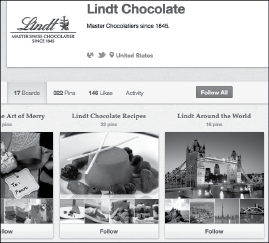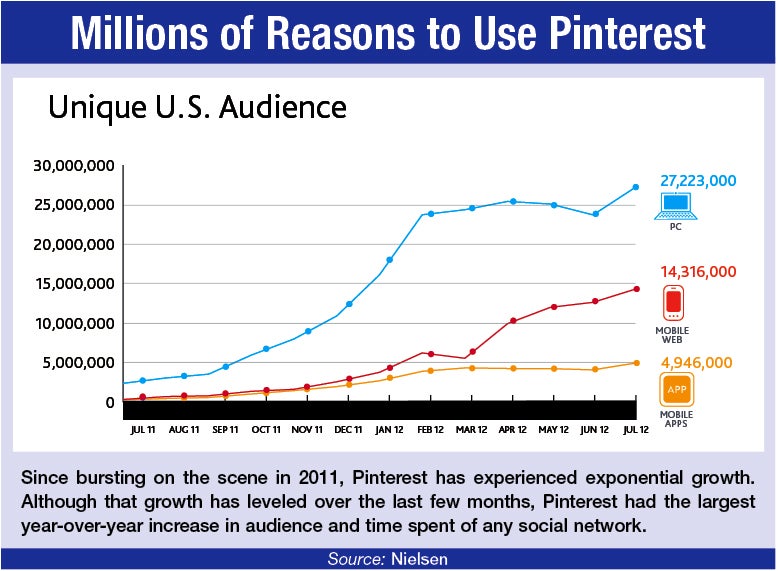While it’s no surprise that Nielsen’s latest Social Media Report finds Facebook the most-visited social media site in the U.S. (with 152.2 million PC visitors year-to-date), another social platform now used by many communicators is challenging Facebook for digital superiority: Pinterest. Nielsen reports that the social site boasts the largest year-over-year increase in audience—1,698%.
The visually oriented social platform is proving popular in showcasing both products and services, and driving eyeballs to websites. But, until last month, PR pros had to set up Pinterest accounts as individuals. That’s changed, thanks to Pinterest for Businesses. The feature, which launched on Nov. 14, enables setup for business accounts.
Here’s what the offering entails:
• PR pros who already have an account set up can convert it to a business account;
• Registration allows for a business name only (not first or last name of an individual);
• Brands are encouraged to add Pin It and Follow buttons to their websites, and embed widgets showcasing their pins;
• Pinterest has updated the Terms of Service to officially allow for commercial activity on the site; and
• A business microsite (http://business.pinterest.com/) displays case studies from brands like Etsy and Jetsetter, and best brand practices and guidelines.
To some PR mavens, the move by Pinterest suggests a monetization play in the near future. But, mainly, it’s a statement that Pinterest is “open for business,” says Monte Lutz, executive VP, social strategy and programming at Edelman Digital. “These changes show that Pinterest is becoming more open to partnering with and promoting brands,” he says. Ultimately, Lutz says the company will need to demonstrate that it can turn visual conversation into revenue conversion.
A holiday campaign, 30 Days of Pinspiration, proves Pinterest is already headed in this direction: The campaign reveals a new person or brand each day for their followers to discover.
BUSINESS AS USUAL
Yet, for many brands on Pinterest, it’s been business as usual even before the new business designation. Katya Blum, social media manager at chocolate maker Lindt, has made Pinterest a priority for the brand. Blum and her team benefit from their products’ visual sumptuousness, and rich history—which play particularly well on Pinterest. “We love to reward consumers by highlighting their do-it-yourself projects that demonstrate creative recipes,” Blum says.
 |
| Pinterest is a key social platform for chocolate maker Lindt, which highlights its followers’ do-it-yourself holiday projects and recipes. Of course, the brand benefits from delicious images. |
With the new Pinterest for Businesses portal, Blum is most interested in the new domain source feature, which lets PR pros know what type of branded content users are sharing most frequently.
METRICS MISSING
The lack of measurement tools has been a sore spot with brands since the platform launched in 2010. “The analytics piece is missing,” says Rebecca Corliss, head of social media and content at marketing software company HubSpot.
For HubSpot’s Pinterest pages, Corliss wishes she could gauge on an aggregate level the number of “re-pins” from one board to another. “Who has the time to count all those up?” Corliss says. Edelman’s Lutz points out that outside services, such as Curalate, provide the bulk of data on pins, re-pins, likes, shares and impressions.
However, the lack of such in-house capabilities, à la Facebook Insights, doesn’t seem to be causing brands to bolt from Pinterest. Alex Nicholson, VP at Cone Communications, says there are three trends that are fueling the growth of Pinterest:
1. The launch of private boards. This lets users set up boards that can be seen only by them and others they choose;
2. An increased focus on posting original content, “so brands don’t get caught up on rights issues,” Nicholson says; and
3. Subtle product placement in pins. Beauty or food brands are featuring more and more products in the shots.
 |
Another trend is the further integration of Pinterest into other platforms. For its Easter 2012 program, Lindt USA partnered with Autism Speaks to raise funds and awareness for the organization, triggered by consumers purchasing Easter products and sending e-cards.
Lindt added Pinterest to the mix with a component called #Pin4Autism, in which the company donated up to $10 to Autism Speaks for every re-pin of photos from a board with Easter pictures. “The giveback was a great incentive for our followers to further engage with our page and spread awareness of program being activated both on and offline,” Blum says.
Of course, some businesses don’t translate to Pinterest’s visual platform as well as others. But many B2Bs appear to be thriving there, says HubSpot’s Corliss. She likens the B2B Pinterest process to the e-commerce shopping cart/checkout process. HubSpot pinned an e-book on its page, which when clicked leads to a landing page where the book can be downloaded.
If you’re still not sold on Pinterest, or have pulled back on your resources for the platform, you might want to reconsider. According to VentureBeat, Pinterest drives higher first touch revenue per click than Twitter or Facebook. Can’t beat that. PRN
CONTACT:
Monte Lutz, [email protected]; Katya Blum, [email protected]; Rebecca Corliss, [email protected]; Alex Nicholson, [email protected].
Follow Scott Van Camp: @svancamp01
